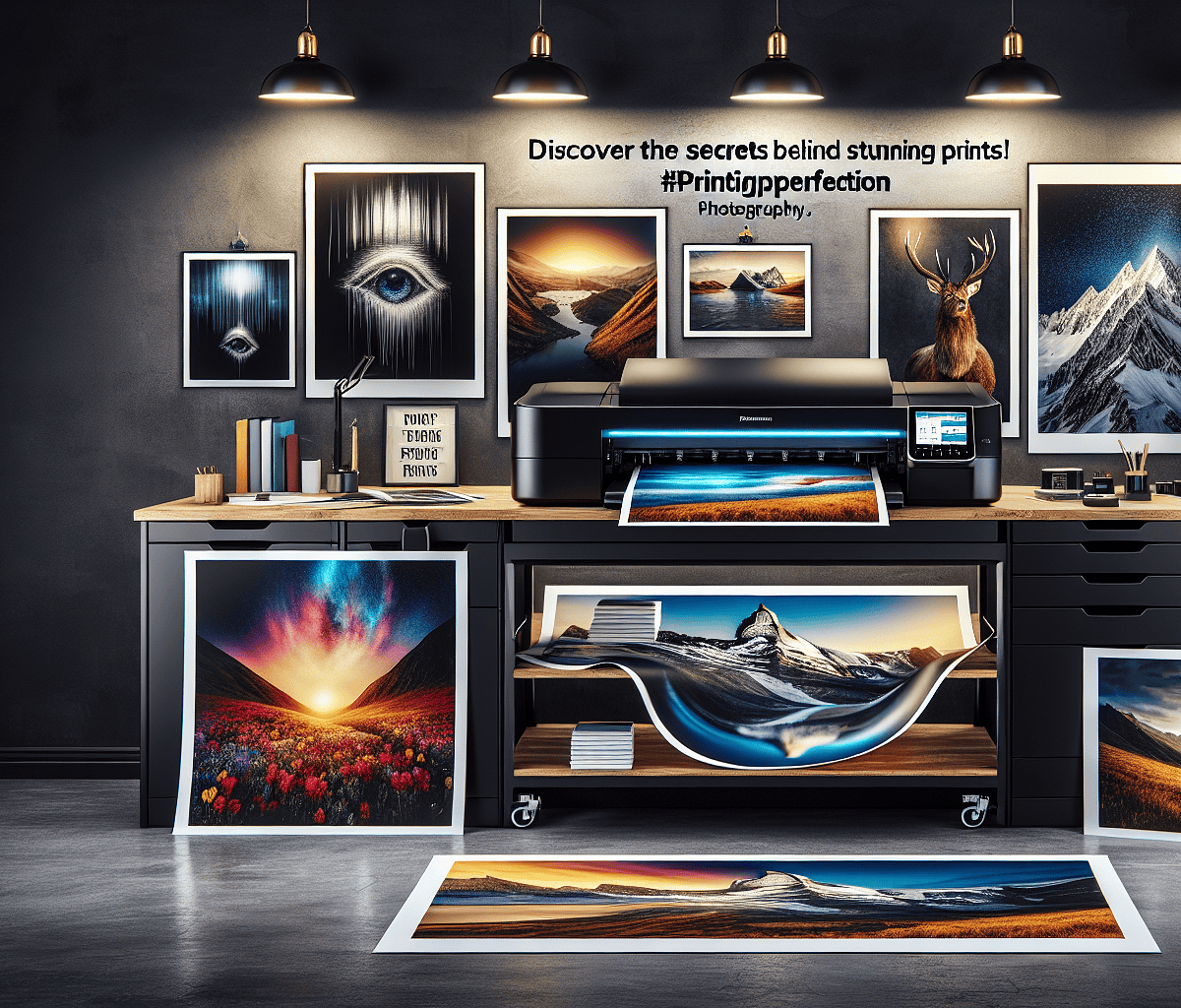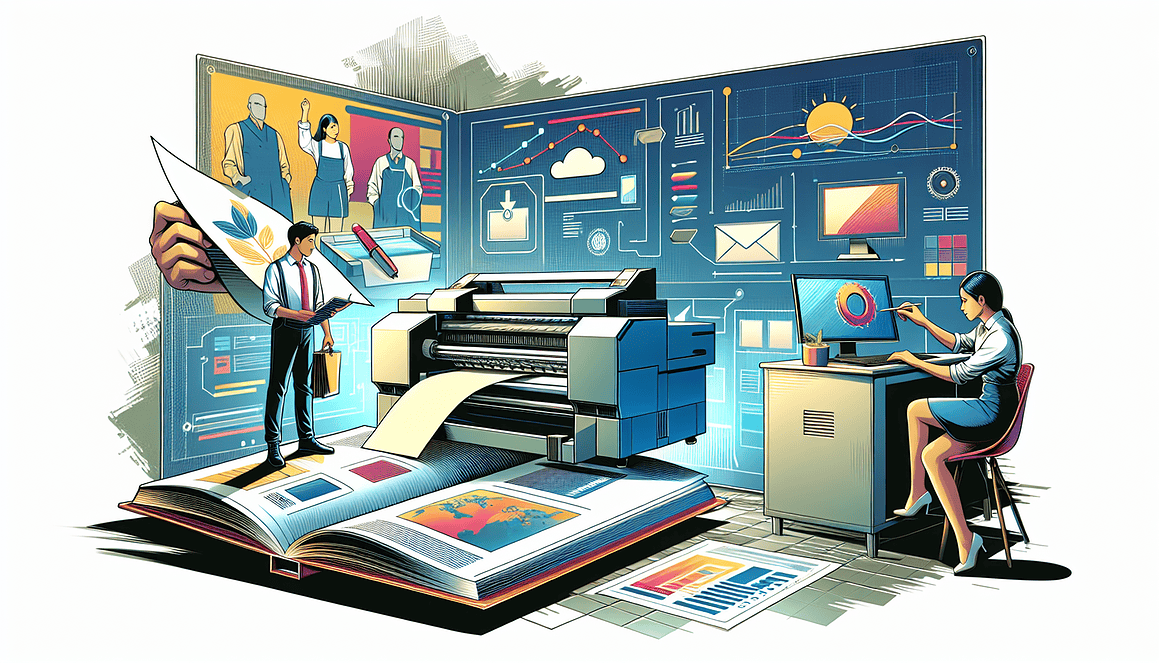Determine your professional printing needs
In a world of constant technological evolution, choosing a professional printing solution adapted to your business is no easy task. Through this article, you will discover the keys to determining your needs and thus equipping your work environment with the best possible tools.
Take Inventory of Your Current and Future Needs
Before even considering the choice of equipment, a thorough study of current and future printing needs is essential. Asking what types of documents are commonly printed in your organization can reveal specific requirements such as the need for multifunction printers or the ability to print in large format.
Criteria for Selection of a Professional Printer
Choosing a professional printer should not be left to chance. Here are some essential criteria to consider in your decision making:
- Print quality: For commercial documents, choose laser printers whose quality is often superior.
- Cost per page: Models like the Epson ET 4700 stand out for their economy in use.
- Print speed: A critical factor for environments with high print volume.
- Reliability and durability: For intensive use without worries. The top 5 Canon printers are often a wise choice for reconciling performance and endurance.
- Additional Features: Some multifunctions include copy, scan and even fax functions which can be decisive.
Consider Technological Innovations
Technology is advancing rapidly and with it the new possibilities offered by 3D printers or 3D printing software are sure to appeal. If these technologies match your needs, take the time to read a detailed review of the Flashforge Adventurer 5M Pro 3D printer to understand its concrete contributions to your sector of activity.
Optimization of Printing and Maintenance Flows
Effective management of printing workflows requires the use of dedicated software. This optimization can not only reduce costs but also improve the security of your printed data. Furthermore, a good after-sales service is crucial, choose partners renowned for their seriousness and responsiveness.
Economy and Environment: The Perfect Coupling
Economic and environmental consideration can lead to considering professional printer rental options. This solution can offer not only access to hardware high yield but also stricter control of your expenses, without forgetting the ecological aspects favored by the regular updating of your printer fleet.
In summary, determining your professional printing needs must be accompanied by strategic thinking encompassing quality, costs, technology, and after-sales service. Opt for a printing solution that guarantees maximum efficiency within your company and a perfect match with your professional objectives.
Understand the different printing technologies available

In the world of professional printing, technological advances are profoundly transforming working methods and equipment strategies. Faced with a vast and evolving choice, it is crucial to understand the different printing technologies available. This article aims to guide you through the characteristics and advantages of current printing systems, in order to allow you to choose the solution best suited to your professional environment.
Inkjet Technology: Quality and Versatility
Inkjet printers are renowned for their ability to produce high-quality prints with great detail, especially for images and photos. THE inkjet printers use cartridges that spray tiny droplets of ink onto the paper, allowing for faithful color reproduction. Some high-end models even fall into the very closed circle of printers designed specifically for immortalize your photos, guaranteeing photo prints of unrivaled professional quality.
Laser Printers: Speed and Efficiency
At the opposite end of the spectrum, laser printers excel when it comes to printing speed and efficient handling of large volumes. These laser printers are ideal for environments where printing needs for text documents are high and constant. Thanks to their technology using toner rather than liquid ink, they are also less susceptible to drying out, making them particularly reliable for intensive use.
Cartridge-Free Printers: A Revolution on the Horizon
The year 2024 is announced as a pivotal period for the arrival of printers without cartridges. These newcomers promise to shake up the world of printing with a more ecological and economical operating method. By eliminating the use of disposable cartridges, these printers are taking a more eco-responsible, while reducing the frequency of recharges and associated costs. To learn more about the prospects offered by these innovations, see an overview of best printers without cartridges planned for 2024.
Each technology has its particularities and it is essential to evaluate them according to your specific needs. Whether in terms of image quality, printing speed, or environmental impact, choosing the right one professional printing system is a decision that can have significant impacts on productivity and efficiency within your business. Thus, an in-depth analysis of the printing solutions available will be your best ally for an informed decision.
To summarize, the world of professional printing is full of solutions adapted to each specific need. From high print quality with inkjet technologies, to the volume performance of laser printers and the innovation of cartridge-free models, every company can find the ideal equipment to optimize their printing workflows. It is therefore essential to clearly understand your expectations and constraints to select the equipment that will best integrate into your professional processes.
Key criteria for choosing a printing system

When it comes to selecting the ideal printing system for business needs, several key criteria must be considered to ensure that the final choice is not only cost-effective, but also perfectly suited to operational expectations and requirements. Offering a reading rich in advice, this guide will prove essential to guide you towards the optimal solution.
Before diving into selecting a professional printer, it is essential to conduct a thorough internal audit of its needs. It is necessary to define the monthly printing volume, the nature of the documents to be printed (texts, graphics, photos), as well as the importance of color in these documents. The options of digitization, of photocopy and of fax are they necessary? Will it be relevant to opt for a printer multifunction ?
The initial cost of a printing system is just the tip of the iceberg. Indeed, the total cost of ownership (CTP) also includes expenses related to ink, toner, maintenance, repairs and energy consumption. Sometimes a slightly larger investment upfront can result in considerable savings in the long term.
Printing technology must be chosen carefully. Depending on the nature of the tasks, a printer inkjet could be preferred for its color printing quality, while a laser will offer speed and lower operating costs for large volumes of text. For specific applications, a printer thermal could be more appropriate, especially for editing labels or receipts. Innovations in 3D printing could also prove essential for specific sectors.
A printing system must be able to integrate seamlessly into the existing technology ecosystem. Compatibility with different operating systems and the company network, as well as the ability to manage print workflows, are essential for optimal daily productivity. Intelligent print management tools such as print management systems tracking and the solutions of fleet management enable better cost control and efficiency.
Support from qualified professionals for maintenance and troubleshooting is crucial. Good after-sales service extends the life of the printer and ensures maximum equipment availability. The possibility of subscribing to a contract of all-inclusive service, including regular maintenance and the supply of consumables can be a wise option.
Renting professional printers is becoming an increasingly popular option. It offers access to high-end equipment without tying up significant capital and often includes maintenance and consumables in the rental contract. So, for professionals who want to stay on the cutting edge of technology while managing expenses, leasing may prove to be an attractive alternative.
Considering these key criteria, selecting a professional printing system becomes a structured and thoughtful process. To further research in this area, consulting guides and detailed tests on the best printers on the market, such as those available on reference sites, proves very beneficial to make an informed and relevant choice.
Analyze total cost of ownership

In the current economic landscape, controlling expenses is essential for every organization concerned with its sustainability. The acquisition of a professional printing system is no exception to this rule. Beyond the purchase or rental price, it is the total cost of ownership (TCO) which must be scrutinized with the greatest attention. This takes into account all direct and indirect costs associated with the purchase, use, maintenance and even renewal of printing equipment. Let’s start a hunt for hidden costs to ensure you make a wise and lasting choice.
Acquisition and commissioning costs
The first step is to evaluate the initial costs : purchase or rental of equipment, installation, and training necessary for the proper use of the equipment. If these costs seem obvious, they only form the tip of the iceberg and should not overshadow the additional costs that may be added to the initial bill.
Ink, toner and consumables
The crux of the matter in the world of printing often lies in managing consumables. Ink and toner can quickly add to the overall bill. It is therefore essential to look at the lifetime and the cost of these consumables, taking care to choose models whose consumption is optimized.
Maintenance and repairs
It is essential not to underestimate the impact of maintenance services on the TCO. Unplanned breakdowns and repairs can cause significant costs, not to mention the impact on business continuity in the event of equipment downtime. It is therefore appropriate to choose a printing system accompanied by a responsive and economically advantageous maintenance service.
Energy efficiency and sustainability
Environmental impact is today inseparable from cost management. Printing systems should be evaluated in terms ofenergy efficiency and sustainability, not only for ecological reasons but also to reduce energy-related costs and guarantee increased longevity of the equipment.
End of life costs
Finally, end-of-life costs of printing systems, including recycling or secure destruction of equipment, can also impact TCO. Anticipating these costs allows you to better control the overall budget allocated to professional printing and to promote a circular economy.
A closer look at TCO often reveals potential savings significant. This is an essential analysis for any decision-maker looking for a printing solution that is not only efficient but also economically viable in the long term. A low TCO printing system provides undeniable added value for companies wishing to optimize their processes while controlling their budget.
For professionals wanting to conduct their own investigation on the subject, there are additional resources that uncover the intricacies hidden behind the TCO of printing systems. These detailed analyzes illustrate the importance of considering all aspects relating to professional printing equipment for informed and efficient management.
By favoring an exhaustive approach in evaluating the total cost of ownership, we ensure that we make informed choices that will serve the financial and operational interests of the company in the long term. This careful and thoughtful strategy is the key to avoiding unpleasant surprises and unforeseen expenses that could compromise the financial health of the company.
Evaluate print quality and resolution
To decide on the acquisition of a professional printing system, two crucial criteria must be scrutinized with the greatest attention: print quality and the resolution. These two aspects, intrinsically linked, will determine not only the clarity of your documents, but also the integrity with which the most subtle details of your graphic or photographic creations will be transcribed.
Understanding Print Quality
Print quality is an overall metric that encompasses color accuracy, image sharpness, and text clarity. For professional use, it is imperative that your prints reflect a level of excellence corresponding to the image of your company. It is influenced by various parameters such as the type of toner or ink used, the precision of the printer and the quality of the paper you are printing on.
For high-quality color printing, color laser printers are often favored for their efficiency and speed. The most efficient models offer impeccable print quality that approaches that of professional inkjet printers, while guaranteeing high printing speeds, an essential characteristic when printing volumes are large.
Print Resolution: DPIs Explained
A printer’s resolution is usually expressed in DPI (Dots Per Inch), and denotes the number of individual dots of ink that a printer can produce over a linear inch. The higher the DPI number, the finer the resolution, allowing you to obtain precise and detailed images.
Let’s take the printer as an example. Epson EcoTank ET-8550, which stands out in tests for its ability to produce A3+ quality photo prints without using traditional ink cartridges. For professionals for whom colorimetric fidelity and fineness of prints are essential, this type of equipment provides a response that meets the requirements.
The right balance between performance and cost
It is essential to make a distinction between the initial investment and the operating costs. For example, a 3D printer can be a good choice for prototyping designs in metal, resin or plastic, providing another dimension to the quality and resolution of three-dimensional models. However, the scope of its use and control of its purchasing cost must be weighed against the specific needs of your business.
Renting professional printers then presents itself as a viable option, allowing you to benefit from cutting-edge equipment without worrying about depreciation or maintenance. The after-sales services included in such arrangements ensure that the performance of your printing system remains optimal, without unforeseen costs.
Choose your printing system according to your sector of activity
Finally, the selection of a printing system must be made according to the sector of activity and the specific needs of the company. A precise analysis of the best devices and services on the market is essential. By considering the range of printers available, such as the best laser printers 2024 or top-rated photo printing services, it is possible to zero in on the tool that will add value to your business processes.
By refining your selection criteria based on recent product comparisons and tests, you will be able to identify equipment that not only meets your quality and resolution needs, but also fits into a perspective of sustainable development and long-term economic management.
In conclusion, whether you are looking to print vibrant brochures, precise architectural plans or striking photos, the choice of your professional printing system is decisive. It must be the result of strategic thinking aligned with the objectives and brand image of your company. By prioritizing quality and resolution, and considering innovative and adaptive solutions such as rental and after-sales service, your investment will guarantee success and satisfaction for you and your customers.


Leave a Reply